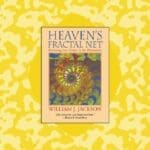 William J. Jackson participated in the Bellagio residency program in 2000. During this residency, he worked on Heaven’s Fractal Net: Retrieving Lost Visions in the Humanities (Indiana University Press, 2004). William is Professor Emeritus at Purdue University, where he taught courses in Comparative Religion in the Department of Religious Studies for 25 years.
William J. Jackson participated in the Bellagio residency program in 2000. During this residency, he worked on Heaven’s Fractal Net: Retrieving Lost Visions in the Humanities (Indiana University Press, 2004). William is Professor Emeritus at Purdue University, where he taught courses in Comparative Religion in the Department of Religious Studies for 25 years.
A few words with William
“While at the Bellagio Center, I focused on the uses and symbolic meanings of fractal patterns. From my studio by the lake, seeing the Alps when I looked up, I could explain more fully the reasons I found fractals to be such a promising theme in structures from the cosmic scale to the microscopic.
“The other researchers were a supportive community, and we discussed many projects at meals. At one of our get-togethers I read a poem I wrote. It was about my father, a soldier who served in Europe during WWII, returning to America with a painting of the Alps. Alpine peaks and slopes showed the self-similarities of fractals.
“The most challenging part of my project involved planning the exact placement of images. I wanted the book to encourage contemplative approaches to fractals. Sometimes pairing fractal shapes in graphics with some verses on fractals leavened the prose discussions with reflective rhythmic explorations.”
A quote from Heaven’s Fractal Net
“Probably only by creatively entering into the ways of fractals personally, following a natural fascination, exploring playfully, will you really see what I mean about their potential. Your contemplative involvement would begin to reveal how fractals can unfold possible understandings of wholeness, because fractals show boundaries in existence and also dissolve differences in integrating them into larger wholes. Fractals reveal the possibility of seeing units, parts, elements, individuality’s assertions, and also the larger actualities of wholeness, unfolding self-transcendence in the One, the ‘meta-fractal’ that connects the scales and dimensions of existence. So many explorations are underway, from visual arts, music, and dance, to scientific writings about ‘fractal thinking’ and ‘the philosophy of fractals’ that it seems premature to conclude much about the unfolding future possibilities… Pursuing fractal connections, in math, in nature, and in the contemplation of patterns, begins to reveal their amazing potential. Exploring fractals can tap their usefulness as dynamic models of relationships, templates of possibilities, and generative stimulators of ideas.”
Synopsis
Heaven’s Fractal Net explores the uniquely useful geometrical forms found in nature and in cultures of the world. Fractals appear in images and designs with reiterated patterns whose parts are self-similar to the whole pattern – just as a fern frond is structured with smaller and smaller self-similar branches. The fractal-like imagery in religious architecture has been used to symbolize infinity, consciousness, vertigo, and wonder. In nature, fractals serve as dynamic configurations for circulation, including the branching shapes of trees and lungs, rivers and nerves.
A wealth of fractal examples can be found in the arts, symbols, and decorations. Heaven’s Fractal Net explores self-similarities in worldwide cultures, providing a rich background for examining many geometrical shapes used by humanity, exploring processes of creativity in wisdom traditions, and delving into archetypal images in depth psychology. Fractals offer an organizing principle for many different kinds of hierarchies and composites, and in recent years “fractal” has become a familiar household word for a new yet ancient geometry.
Explore More
To find out more about William’s work, you can visit his academia website.